Large-Scale Municipal Solar Array Ribbon Cutting
A public ribbon cutting and tour are scheduled for Thursday, July 21 at 10am at the site of the second largest solar array in New Hampshire. The ceremony will be held at 411 Packers Falls Road in Lee, near the intersection of Jenkins Road.
The 651-kilowatt Oyster River Forest Solar Array is the largest project to date for the installer, New England-based ReVision Energy. IGS Solar, a turn-key commercial and residential solar provider, financed and owns the array. The Town of Durham owns the site.
After decades of use as a gravel pit, the site has been repurposed to serve several new, long-term functions for the town, including a utility-scale solar array, a drinking water well, an aquifer recharge system and a variety of public works activities compatible with the primary uses.
The array generates 100% of Durham’s municipal electric load, with the exception of the waste water treatment plant. Power in excess of the town’s needs supplies some of the electric load for the Oyster River Cooperative School District.
Durham Energy Committee Chairman Charles Forcey says, “The Oyster River Forest Solar Array is an unprecedented collaboration between two municipalities, two pioneering, private solar companies, a cooperative school district and the Public Utilities Commission of New Hampshire. With immense gratitude toward its partners in this utility-scale effort, the Town of Durham celebrates this landmark achievement toward our overarching goal to secure a clean, affordable and secure energy supply for our municipal services."
IGS Solar Vice President Patrick Smith says, “We are glad to be a long-standing sustainability partner to the Town of Durham by helping them control their energy costs with solar.”
The array, which was commissioned in June, is a fixed ground mount consisting of 2,100 solar modules installed across 14 rows. Since its commissioning, the array has produced an average of four megawatt hours of electricity each day. If the project were designed as one continuous array and not a series of rows, it would span the length of 11.5 football fields.
Annually, the array is expected to generate approximately 859,300 kilowatt hours of electricity, which is equivalent to offsetting the carbon dioxide emissions from 1,464 barrels of oil or 71,436 gallons of gas or the annual electricity use of 115 New Hampshire homes.
Images

Date and Time
Thursday Jul 21, 2016
Thursday, July 21
10 am
Contact Information
Christina Zlotnick
Send Email



